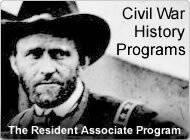
Escape of an Assassin
The Smithsonian Associates Civil War E-Mail Newsletter, Volume 6 , Number 7
In the fall of 1864, the popular actor John Wilkes Booth arrived in Southern Maryland, a haven for Confederate sympathizers, with letters of introduction from exiled Confederates in Canada and a scheme to kidnap President Abraham Lincoln. Booth soon gathered recruits to assist him. Whether the Confederate high command in Richmond, Virginia, sanctioned the plan or Booth retaliated on his own for what he perceived as Lincoln's harsh wartime policies is unclear. By April 1865, however, Booth had abandoned the kidnap plot in favor of assassination. On April 14, shortly after 10 p.m., Booth shot Lincoln in the back of the head while the president watched a play at Ford's Theatre in Washington DC.
Booth fled over the Navy Yard Bridge into Southern Maryland. With fellow conspirator David Herold, he stopped about midnight at widow Mary E. Surratt's tavern in the village of Surrattsville. She was then operating a boardinghouse in Washington DC but a tenant at the tavern testified that Booth retrieved rifles, field glasses, and other supplies hidden there as part of the earlier kidnap scheme. The tenant also said that Surratt had been at the tavern as recently as the afternoon of April 14, and had left instructions to have the equipment ready. His testimony was fatal to Surratt, marking the first time that the federal government had executed and hung a woman.
Booth and Herold did not linger at the tavern, but headed south to the village of T.B. and then into Charles County. Their exact route is uncertain, but their destination was Dr. Samuel A. Mudd's home about three miles north of Bryantown. The doctor and Booth had met previously, and Mudd had introduced the actor to a leading Confederate agent, Thomas Harbin, as well as John Surratt, Jr., a Confederate courier and son of Mary Surratt.
The fugitives arrived at the Mudd farm early on the morning of April 15, seeking help for the broken leg that Booth had sustained in his escape. After setting the leg, Mudd allowed the pair to rest in an upstairs bedroom. That afternoon, the doctor went into Bryantown, learned that it was occupied by Federal troops and that the search was on for Lincoln's assassin. Mudd returned home and sent Booth and Herold on their way. The last time he saw them, they were headed in the direction of Zekiah Swamp. Mudd was later sentenced to prison for assisting Booth.
However, the pair did not seek refuge in the swamp. They made a wide arc around Bryantown and were guided to the home of Samuel Cox (near the present-day town of Bel Alton) shortly after midnight on April 16. Cox sent them to a dense pine thicket where they hid for several days, receiving food and newspapers from Thomas Jones, a Confederate signal agent, and Franklin Robey, Cox's overseer. On the night of April 20, Jones led the fugitives to the Potomac River where he had hidden a rowboat. He directed them to Mathias Point on the Virginia shore, but for some reason the pair rowed to Nanjemoy Creek in Maryland, where they rested before trying again the next night.
Once in Virginia, Booth and Herold crossed the Rappahannock River and found shelter at Richard Garrett's farm. There, early in the morning of April 26, 1865, Federal troops found them hiding in a tobacco barn. Herold surrendered as ordered, but Booth refused. To force him out, the barn was set on fire. The soldiers could see Booth through the slats in the barn, and Sgt. Boston Corbett shot him in the back of the neck. Soldiers dragged Booth onto the porch of the nearby farmhouse, where he died a few hours later. Herold was returned to Washington DC where he stood trial and suffered death on the gallows.
Of those who helped Booth escape through Maryland, only Herold, Mrs. Surratt and Dr. Mudd were prosecuted. Cox, Jones and others associated with the assassin's flight were released after several weeks in jail. Jones wrote a book, J. Wilkes Booth (1893), about his experience.

Article from the Maryland Civil War Trails Guides, used with permission.
Visit www.visitmaryland.org for more Maryland Civil War links.
Visit our Booth Escape Route Online Tour to experience history first hand!

